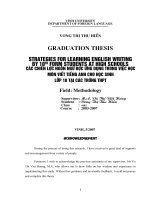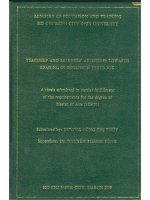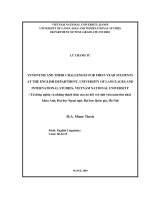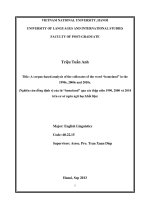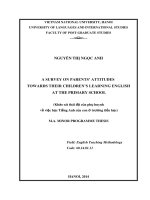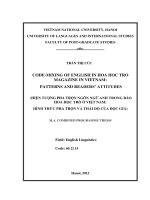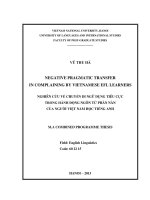Learners’ attitudes towards native and nonnative English speaking instructors = Thái độ của người học đối với giáo viên bản ngữ và giáo viên người Việt
Bạn đang xem bản rút gọn của tài liệu. Xem và tải ngay bản đầy đủ của tài liệu tại đây (493.75 KB, 57 trang )
VIETNAM NATIONAL UNIVERSITY, HANOI
UNIVERSITY OF LANGUAGES AND INTERNATIONAL STUDIES
FACULTY OF POST- GRADUATE STUDIES
********************
LÊ THỊ PHƯỢNG
LEARNERS’ ATTITUDES TOWARDS NATIVE AND
NONNATIVE ENGLISH SPEAKING INSTRUCTORS
(THÁI ĐỘ CỦA NGƯỜI HỌC ĐỐI VỚI GIÁO VIÊN
BẢN NGỮ VÀ GIÁO VIÊN NGƯỜI VIỆT)
M.A. MINOR PROGRAMME THESIS
Field: ENGLISH TEACHING METHODOLOGY
Code: 60.140.111
Hanoi, 2014
VIETNAM NATIONAL UNIVERSITY, HANOI
UNIVERSITY OF LANGUAGES AND INTERNATIONAL STUDIES
FACULTY OF POST- GRADUATE STUDIES
********************
LÊ THỊ PHƯỢNG
LEARNERS’ ATTITUDES TOWARDS NATIVE AND
NONNATIVE ENGLISH SPEAKING INSTRUCTORS
(THÁI ĐỘ CỦA NGƯỜI HỌC ĐỐI VỚI GIÁO VIÊN
BẢN NGỮ VÀ GIÁO VIÊN NGƯỜI VIỆT)
M.A. MINOR PROGRAMME THESIS
Field: ENGLISH TEACHING METHODOLOGY
Code: 60.140.111
Supervisor: Dr. DƯƠNG THI
̣
NU
̣
Hanoi, 2014
i
DECLARATION
I declare that the thesis entitled “Learners’ attitudes towards native and
nonnative English speaking instructors” is the result of my own research and the
substance of this thesis has not, wholly or in part, been submitted for a degree to any
universities or institutions.
Hanoi, March 2014
Lê Thị Phượng
ii
ACKNOWLEGEMENTS
To fulfill the task, I have received a great deal of useful and practical support from
many people.
First of all, I would like to express my deepest gratitude to my supervisor Dr.
Dương Thị Nụ, who has guided me to do this thesis. But for her expert guidance,
insightful comments and constructive feedback, my thesis would still be far from
completed.
Also, my special thanks are sent to all the lecturers who have been teaching K20
MA course in Vietnam National University, Hanoi – University of Languages and
International Studies, and the post-graduate staff for their legitimate contributions to
the success of the course.
Last but not least, my deepest appreciation goes to my friends Doan Minh Mao,
Bich Nguyen, Oanh Nguyen as well as my mother and my parents-in-law for their
enduring love, continued support and encouragement that helped me to finish the
thesis.
Hanoi, March 2014
Lê Thị Phượng
iii
ABSTRACT
This study investigated the learners‟ attitudes towards teaching methods
applied in speaking classes by native English speaking and non-native English
speaking instructors in an English center in Hanoi. The research participants
included 50 Vietnamese learners of various educational backgrounds. By
administering a closed-ended and self-report questionnaires as well as semi-
structured interviews, the study revealed that learners perceive considerable
differences in the ways NES and NNES instructor apply teaching methods. Besides,
generally NES instructors were perceived as better oral teachers. However, in terms
of specific areas in teaching speaking namely grammar and learning strategies,
students showed favorable attitudes to NNES instructors. On the other hand, NES
instructors are preferred as pronunciation and vocabulary teachers.
iv
TABLE OF CONTENTS
ACKNOWLEDGEMENTS ii
ABSTRACT iii
TABLE OF CONTENTS iv
LIST OF TABLES AND APPENDICES vi
LIST OF ABBREVIATIONS vi
PART I: INTRODUCTION 1
1. Rationale of the study 1
2. Aim of the study 3
3. Research questions 3
4. Scope of the study 3
5. Methodology of the study 3
6. Design of the study 3
PART II: DEVELOPMENT 5
CHAPTER 1: LITERATURE REVIEW 5
1.1. The Native Speaker definition 5
1.2. Native and non-native teachers 7
1.3. Previous researches on students‟ attitudes towards NESTs and NNESTs 10
1.4. Summary 17
CHAPTER 2: METHODOLOGY 18
2.1. Research setting of the study 18
2.1.1. An overview of the research site 18
2.1.2. Description of the instructors and the IELTS 5.5 and 6.5 courses 18
2.2. Research questions 19
2.3. Participants of the study 19
2.4. Data collection instruments 19
2.4.1. Questionnaire 19
2.4.2. Semi-structured interviews 20
v
2.5. Data collection procedure 21
2.6. Data analysis procedure 22
2.7. Summary 23
CHAPTER 3: DATA ANALYSIS AND FINDINGS 24
3.1. Differences between NES and NNES instructors 24
3.1.1. Native English Speaking Instructors‟ teaching methods 24
3.1.2. Non-native English Speaking Instructors‟ teaching methods 27
3.1.3. Comparing results 29
3.2. Learners‟ attitude towards native and non-native English speaking instructors 29
3.2.1. Teaching Pronunciation 31
3.2.2. Teaching Vocabulary 32
3.2.3. Teaching Grammar 34
3.2.3. Teaching learning strategies 35
3.2.4. Other findings 36
3.3. Summary 38
PART III: CONCLUSION 39
1. Recapitulation 39
2. Implications of the study 39
3. Limitations of the study and suggestions for further study 40
REFERENCES 41
APPENDIX
vi
LIST OF TABLES
Table 1: Responses for NES instructors‟ teaching method – as seen by the learners
24
Table 2: Responses for NNES instructors‟ teaching method – as seen by the
learners 27
Table 3: Preference to NES instructors for specific areas 29
Table 4: Preference to NES instructors for specific areas 30
LIST OF ABBREVIATIONS
M.A: Master of Art
L2: Second language
L1: First language
NS: native speaker
NNS: nonnative speaker
NES: Native English speaking
NNES: Non-native English speaking
NESIs: Native English speaking instructors
NNESIs: Non-native English speaking instructors
NESTs: Non-native English speaker teachers
NNESTs: Non-native English speaker teachers
CEFR: Common European Framework of Reference for Languages
1
PART I: INTRODUCTION
1. Rationale of the study
It is widely recognized that English is an international language and is now
used as a main tool for global and intercultural communication around the world.
As a result, there is an increasing number of people trying to master this language.
In Vietnam, many students try to enhance their English competence by taking part
in English courses, which results in the increasing influx of foreign teachers coming
to Vietnam to teach English.
However, the role of native speakers and nonnative speakers as instructors of
English has been a controversial issue in recent years. Despite the fact that non-
native English speaking ( NES) instructors around the world outnumber the native
English speaking (NNES) instructors by far ( Samimy & Brutt- Friffler, 1999),
numerous cases of discrimination against NNES instructors have been reported and
NES instructors are preferred over NNES instructors when they are applying for the
same position (Braine, 1999). Indeed, there is a stereotype that native English
speaking instructors are the ideal language instructors. According to Wong (2009),
many employers of private language centers and public schools in non- English
speaking countries, especially in Asia, have begun recruiting NESIs to teach at their
centers or schools. These schools or centers often put emphasis on having NESIs as
their strength. According to the researcher‟s observation the findings from these
studies may, to some extent, be similar to the situation of her teaching context. It is
not uncommon to see some native speakers with different backgrounds and in
different study areas going to Vietnam to teach English to make money when they
travel overseas. In fact, as cited in “Native English-speaking teachers in Vietnam:
Professional identities and discourses of colonialism” by David Bright (2012), in
Vietnam, NES teachers including those with minimal or no qualifications or
teaching experience, enjoy greater access to jobs with vastly superior benefits and
2
conditions than do many Vietnamese English teachers who have completed higher
degrees in Western English-speaking countries.
It is not rare to see advertisements from private language centers and schools
emphasizing on having NES instructors as one of their competitive advantages. As
indicated in “Are native speakers “good” language instructors? A case study of
untrained ESL tutors” (2009), to show the world‟s strong preference for native
English teachers, Moussu (2006) reports that in a quick visit of a famous
international ESL website, she found the majority of the ESL jobs listed on the job
board were offered to native English teachers only. Through a doctoral research
namely “ Status of non-native English teachers as ESL teachers in the USA”,
Mahboob found that the number of NNS teachers teaching ESL in the United States
is low (only 7.9% of the teachers employed at these programs), and that this low
figure is disproportionate to the high number of NNS graduate students enrolled in
MA TESOL and similar teacher-education programs. Mahboob attributes the low
figure to the preference given by most (59.8%) program administrators to “native
English speakers” in hiring practices.
According to Braine (1999), a commonly- used explanation for the
discrimination against NNES teachers is that students prefer to be taught by native
speakers. However, it is still doubtful whether students do show a preference for
NES teachers. While researchers have explored problems related to native speaking
versus non-native speaking instructors at length in recent years, language educators
and researchers in Vietnam have been quite silent on this topic. Specifically,
Walkinshaw and Duong (2012) is the only study which investigated the relative
value perceived by Vietnamese EFL students from tertiary institutions to native and
non-native teachers. However, as the authors suggested that research should be
conducted in other educational contexts such as high schools or private language
institutions may increase the findings‟ generalisability. As a result, it is worthwhile
to explore the problems from the students‟ perspective in order to ascertain whether
students prefer native English-speaking teachers over non-native counterparts.
3
Moreover, it is also worth finding out the differences in teaching methods between
the two groups of teachers. For such reasons I choose “Learners’ attitudes
towards native and nonnative English speaking instructors” which was
conducted at a private English center as a theme for my thesis.
2. Aims of the study
This study is carried out with the aim to identify the differences between
native and non-native English speaking instructors as perceived by students, with
regard to instructors‟ teaching behavior in speaking classes.
3. Research questions
To achieve the aim mentioned above, the following research questions were
raised for exploration:
1. What do learners perceive as the differences between native and non-
native instructors with respect to their teaching methods through speaking
lessons?
2. Do learners perceive NES instructors superior to their nonnative
counterparts?
4. Scope of the study
This study focuses on students studying IELTS courses at EQuest Hanoi.
Particularly, this minor thesis only refers to the categorization of the students'
attitudes towards the differences between NES and NNES instructors with regard to
their teaching behaviour in speaking lessons.
5. Methodology of the study
Since my minor thesis is an empirical research, I choose quantitative and
qualitative research methods. To be more specific, I will collect qualitative data
using semi-structured interviews as well as quantitative data using closed questions.
6. Design of the study
The study is intended to consist of three parts as follows:
4
Part I is the Introduction which give reasons for choosing the thesis, aims and
objects and scope of the study as well as the methodology of the study.
Part II is the Development which will be divided into three chapters:
- Chapter I: Literature review provides concepts of native speaker, native and non-
native teachers in ELT, and some studies on students‟ attitudes towards native and
non-native instructors.
- Chapter II: Methodology provides the readers with the data collection
instruments. Detailed information about the research procedure and the participants
of the study is also presented.
- Chapter III: Data analysis and findings presents and analyzes the data collected
from the questionnaires and from students‟ interviews.
Part III is the Conclusion which reviews the study, presents the suggestions for the
teachers, the limitations of the study and suggestions for further study. Following
part III is the References and Appendices.
5
PART II: DEVELOPMENT
CHAPTER 1: LITERATURE REVIEW
1.1. The Native speaker definition
It is difficult to define what it means to be a native speaker of a language,
especially with respect to English. In this passage, I will review some definitions of
the native speaker based on some research in the fields of Second Language
Acquisition and language teaching.
In “Language” (1933), Bloomfield states “ The first language a human being
learns to speak is his native language; he is a native speaker of this language”. In
other words, a native speaker of English is traditionally defined as someone who
speaks English as his or her native language, also called mother tongue, first
language.
The next question is what qualifies someone as a native speaker? According
to Davies in “ The native speaker in applied linguistics” (1991), the word “ native”
suggests that an individual is a “native speaker of a language by virtue of place or
country of birth” which means that the individual acquired the language from birth.
However, as stated by Lee (2010), this is insufficient in determining whether an
individual is a native speaker of a language, or not, since individuals can be
resettled to other places in childhood, as in the case of children who immigrate or
are adopted in early childhood. Brutt-Gruffler and Samimy (2001) recommends that
“nativeness” constitutes a socially constructed identity rather than a linguistic
category. Pronunciation is reported to play such an important role in determining
native identity:” Pronunciation may most obviously provide clues for non-native
status since it is formed in early age and may be the least conscious element is
speech” ( Gimson, in Paikeday, 1985: 23). To Kramsch, the native speaker status is
determined by “acceptance by the group that created the distinction between native
and nonnative speakers‟ (1997: 363). Whether international speakers of English are
6
considered as “native” or “non-native speaker” depends on various social
parameters, such as the preconceived notions of what native speakers should look
like or sound like (Bruitt-Griffler & Samimy, 2001).
Lee (2010) isolated six defining characteristics of a native speaker that a
number of researchers in the field of Second Language Acquisition and language
teaching support as follows:
1. The individual acquired the language in early childhood (Davies, 1991;
McArthur, 1992; Phillipson, 1992) and maintains the use of the language (Kubota,
2004; McArthur, 1992),
2. the individual has intuitive knowledge of the language ( Davies, 1991; Stern,
1983),
3. the individual is able to produce fluent, spontaneous discourse ( Davies, 1991;
Maum, 2002; Medgyes, 1992),
4. the individual is communicatively competent (Davies, 1991; Liu, 1999; Medgyes,
1992), able to communicate within different social settings (Stern, 1983),
5. the individual identifies with or is identified by a language community (Davies,
1991; Johnaon & Johnson, 1998; Nayar,1998)
6. the individual does not have a foreign accent ( Coulmas, 1981; Medgyes, 1992;
Scovel, 1969, 1988).
The question is that whether a nonnative speaker can become a native
speaker . As Lee concluded in his paper named “ The Native Speaker: An
Achievable model?”, it is impossible for any learner of a language, after the critical
period, to become a native speaker unless he or she is born again. It is impossible
because in order to be considered as a native speaker of a language, a person must
satisfy the one most salient criterion-acquire the language in early childhood and
maintain the use of that language. According to Phillipson (1996), a nonnative
speaker, through effective training, can acquire most of the elements that define a
native speaker. Medgyes (1992), however, pointed out many aspects of linguistic
competence pose tremendous challenges for nonnative speakers. Among these
7
difficulties, accents and target cultural competence seems to be the two most
difficult.
1.2. Native and non-native teachers
Medgyes (1992) has brought up the controversy of whether a non-native
speaker can ever become a native speaker or not. He suggests that a non-native
speaker‟s competence is limited, and that only a reduced group can reach near-
native speaker‟s competence, “but sooner or later they are halted by a glass wall”
(1992: 342). On the other hand, Greenbaum ( in Kachru 1985) argues that, “ There
is no doubt that non-native speakers can acquire native-like proficiency in English
as an additional language, whether they belong to the “outer circle” (ESL) or the
“expanding circle” (EFL)” (31).
Reves and Medgyes (1994) administered a questionnaire to ELS/EFL
teachers in ten different countries to study their views on the differences between
the teaching of NESTs and NNESTs. These teachers indicated several points about
NESTs‟ teaching behaviors: 1) NESTs are thought to be less prepared and show less
empathy towards students‟ language struggles; 2) NESTs generally are not familiar
with how language are learned; 3) NESTs tend to be more successful with advanced
learners. From the researcher‟s experience, she strongly agrees with number (1) and
number (2). During the time working with some native teachers at EQuest
Academy, I had a chance to observe their classes and found that most of them did
not prepare the lessons carefully and they seemed to lack patience with students if
students could not fulfill their homework.
Studies of teachers‟ self-perceptions of their abilities in the ESL field have
different results. According to Reves and Medgyes (1994) in an EFL setting
supports the idea that NNS teachers may feel “deficient” in their language skills.
84% of NNSs admitted to having language difficulties, and only 25% of subjects
stated that language difficulties had no adverse effect on their teaching. In their
research, Samimy and Brutt-Griffler (1999) applied the Reves and Medgyes (1994)
to survey and interview 17 NNS graduate students who were either pursuing a MA
8
or Ph.D. in TESOL at a university in the U.S. Similarly to Reves amd Medgyes
(1994), more than 2/3 believed that their own language difficulties affected their
teaching. Nearly 90% of the subjects perceived a difference between NESTs and
NNESTs. They regarded the former group as being fluent, accurate, using different
techniques, methods and approaches, being flexible, using controversial English,
providing positive feedback to students, and having communication (not exam
preparation) as the goals of their teaching. Meanwhile, NNESTs were perceived as
relying on textbooks, applying differences between the first and second languages,
using the first language as a medium of instruction, being aware of negative transfer
and psychological aspects of learning, being sensitive to the needs of students,
being more efficient, knowing the students‟ background, and having exam
preparation as the goal of their teaching. However, while they perceived that NESTs
and NNESTs each possessed strengths and weaknesses, they did not consider the
native speaking teachers superior to their NNS counterparts. Whereas Reves and
Megyes (1994) focus on the differing levels of language proficiency and their
effects on teaching practices, the differing teaching practices identified by Samimy
and Brutt-Griffler (1999) may be attributed to cross- cultural differences.
The study “ Native and non-native English teachers: investigation of the
construct and perceptions‟ (2001) was carried out by Ofra Inbar- Lourie at TEL
Aviv University in Israel. Apart from aiming at figuring out the reasons why some
teachers in Israel perceived themselves as native of English and the effects of the
native versus non-native distinction on the pedagogical perceptions of the teachers,
Inbar-Lourie also specifically sought to discover if there were differences in
perceptions between teachers who claim to be native of English and those who do
not, with respect to the following factors: differences between NSETs and NNSETs
and status of the English language; English teaching in Israel; and English teaching
and assessment methods. I just mention the results for the latter aim which is
relevant to the topic of this passage. The study indicated that differences between
NS and NNS teachers could be detected only in some categories, mainly the
9
superiority of the NS teachers, the degree of confidence in teaching specific
language fields, and in student-teacher relations. The researcher found no difference
in perception categories relating to teaching and assessment practices, defining
students‟ knowledge of English, goals of teaching English as well as the status of
the English language. In fact, the perception differences in these areas happened not
from the teachers‟ status as NS or NNS but from personal and professional variables
such as country of birth, length of residence in the country, school level, and
perceived type of school. NNS teachers reported having better relations with
students and feeling more confident in using the L1 to facilitate teaching.
The last study that I shall review is “Self-awareness in NNS EFL primary
and secondary school teacher” conducted by Llurda and Huguet (2003). Their
purpose was to investigate the self-awareness of 101 NNESTs in primary and
secondary in a Spanish city. They administered a set questionnaire orally in one-on-
one interviews with the subjects, the researchers aimed to determine how the
subjects perceived their own language skills, how these skills affected their
teaching, and how the skills had evolved over time; the participants‟ teaching
ideology as expressed through their preferences for designing a language course and
their goals as language teachers; and the participants‟ positions in the NS- NNS
debate, specifically with respect to the preference for NSs or NNSs as language
teachers, and the need for cultural knowledge on the part of English teacher. In term
of language skills, they found that the secondary teachers showed more confidence
in their skills than primary teachers, especially in general proficiency, grammar
knowledge of grammatical rules and reading comprehension. Although primary
teachers admitted that they did experience certain difficulties in teaching English,
they did not attribute these difficulties to their proficiency in English. In the case of
language courses and language teaching goals, 86% of the primary teachers chose
communicative functions and topics as the foundations for language courses. Only
half of the secondary teachers did so although 38.1% of them opted for language
structures and habit creation than their primary counterparts. Regarding teaching
10
goals, almost all the primary teachers accounting for 97.2% preferred
communicative strategies while only two-thirds of the secondary teachers did so.
An interesting point should be noted is that the primary teachers appeared to be
more influenced by the native speaker fallacy, half of them stating that they would
definitely recruit more native speakers than non-native speakers for a language
school. As for secondary teachers, nearly two thirds chose to hire equal teachers
from both groups. Indeed, most of the secondary teachers (65.6%) believed that
being a non-native speaker was an advantage.
1.3. Previous researches on students’ attitudes towards NESTs and NNESTs
In fact, earlier studies assumed such a bias against non-native speakers and
explored possible reasons behind it. To start with, Medgyes (1992) focused on the
UK, stated that program administrators preferred native speakers because they were
“aware that international students studying in Britain preferred to be taught by
native-speaking English teachers. This demand would have to be satisfied by the
school principal….” (p. 344). Cook (2000) agrees with Medgyes and believes that
the main reason for administrators not hiring NNESTs is their perception that ESL
students who enroll in their language course expect NESTs. Thus, according to
these papers, NNESTs are not hired because program administrators believe that
students do not want them.
Nevertheless, studies of ESL studies‟ perceptions do not corroborate these
beliefs. In one study of students‟ perceptions, Cook (2000), using data collected
through a questionnaire survey, reports,
The NS teacher was preferred by 18% of Belgian 15-year-olds, 44% of
English children, and 45% of Polish children. Looked at in reverse, 47% of
Belgian, 32% of English, and 25% of Polish children preferred non-natives, the rest
having no preference. (p.331)
In discussing these results, he states, “Nowhere is there an overwhelming
preference for NS teacher. Being an NS is only one among many factors that
influence students‟ views of teaching” (p.331). This, his study shows that students
11
do not simply prefer teachers based on their status as on their status as a native or a
non-native speaker, but rather their preferences are more complex. However, while
Cook‟s work shows that students may not have a clear preference for either NESTs
or NNESTs, his work does not explore the reasons for these diverse views.
In another study of students‟ perceptions, by collecting qualitative data from
classroom discussions, interviews and analysis of autobiography writings of student
participants in a graduate TESOL program, Samimy and Bruff- Griffler (1999)
found that students saw NESTs as being fluent and accurate; using different
techniques, methods, approaches and authentic English; giving positive comments
on students and having communication as the goals of their teaching. Meanwhile,
participants viewed NNESTs as depending on textbooks; using mother tongue as a
medium of instruction; understanding students‟ background; being sensitive to the
needs of the students and having exam preparation as the target of their teaching. In
spite of these differences, students did not consider NESTs superior to their
nonnative counterparts.
Likewise, Mahboob‟s research in 2003 which aimed at evaluating ELS
students‟ attitudes towards NS and NNS teachers in the United States and
investigating factors that influence students‟ perceptions of their teachers showed
that ELS in America did not display a clear preference for either NS or NNS
teachers. Mahbbob used the novel and more insightful “discourse-analytic”
technique, asking 32 students enrolled in an intensive English program to provide
written responses to a cue that solicited their opinions on NS and NNS language
teachers. The student essays were coded individually by four readers who in turn
classified the students‟ comments according to linguistic factors namely oral skills,
literacy skills, grammar, vocabulary, culture, teaching styles including ability to
answer questions, teaching methodology, and personal factors (experience as an
ESL learner, hard work, affect). Based on an analysis of students‟ essays, he
reports that students find strengths in the way NNESTs teach them when compared
to NESTs. This is an important finding and shows that students are not naïve and do
12
not necessarily buy into the “native speaker fallacy” (Phillipson, 1992) that only
native speakers can be good language teachers. Both NS and NNS teachers
received positive and negative comments. In the case of NS teachers, the majority
of positive comments related to oral skills, vocabulary and culture. Negative
comments on native speaker teachers related to grammar, experience as an ESL
learner, ability to answer questions, and methodology. To the NNSTs, experience as
an ESL learner earned the most number of positive comment, followed by grammar,
affect, oral skills, methodology, hard work, vocabulary, culture, ability to answer
questions, and literacy. Oral skills and culture were seen as their negative
comments. The findings of this study demonstrate that the importance given to the
“native English speaker” hiring criterion by program administrators is not shared by
students. As Maboob said “ both NESTs and NNESTs working collaboratively can
provide a better learning environment to ESL students”.
Ketch and Santatn- Williamson (2002) examined the attitudes of 56 ESL
students towards NESTs and NNESTs in America. Data were collected by means of
an attitude survey questionnaire and using audio-taped passages read by 3 native
and 3 nonnative English speakers, the researchers found that the students were in
most cases could not distinguish a native English speaker from a nonnative speaker,
and an interesting thing to note is that the attitude towards teachers with different
accent is not correlated with whether a speaker‟s accent is native or nonnative, but
instead is correlated with the students „perception of whether speaker is native or
nonnative. Students viewed a perceived native speaker more favorably than a
perceived NNS. Although students showed a preference for a native instructor in
terms of teaching speaking, listening and pronunciation, they quoted two main
advantages of NNESTs, namely better source of motivation since they could show
students possibility of reaching a higher level of proficiency, and NNESTS had
same difficulties in learning a second language as the students themselves.
David Lasagabaster together with Juan Manuel Sierra (2005) attempted to
examine the pros and cons of having a native speaker teacher. Two questionnaires
13
including both close and open were administered to 76 university students in the age
range of 18-36, with a mean of 19.7. The close questionnaire regard the following:
language skills, grammar, vocabulary, pronunciation, learning strategies, culture
and civilization, attitudes and assessment, and this with respect to primary,
secondary and tertiary education, as differences exist among teachers of different
educational levels (Llurda & Huguet, 2003). Students were given a five-point Likert
scale with regard to each of the 42 statements in the questionnaire. As for the open
questionnaire, students are encouraged to express their opinion freely in the small
group. Their students were clearly concerned about the benefits of a native speaker
teacher in pronunciation and culture. Paradoxically enough, when students
commented on the negative aspects of a native speaker teacher, 8 groups out of 17
groups admitted that a native accent brought about intelligibility problems, in fact
the top negative aspect in the open questionnaire. When the participants spent their
time reflecting and debating on the advantages of having a non-native speaker
teacher, the results (70% of the groups) clearly showed that students highly valued
the NNSTs as a resource of learning strategies throughout the process of learning
English. In general, the researchers found that university students preferred NESTs
in respect to pronunciation, culture and civilization, listening, vocabulary and
speaker whereas they showed a preference for NESTs in terms of grammar and
strategies. One thing should be noticed is that 7 groups expressed their
preoccupation about the lack of professional qualifications and ability to deal with
the teaching of grammar on the part of NSTs. Yet, they did not show any preference
for NESTs or NNESTs in the other areas such as reading, assessment, attitudes
towards English speaking countries and attitudes towards the learning of English.
When they were given the possibility of having both a native speaker teacher and a
non-native speaker teacher, the percentages were even higher 71.6%. These results
coincide with Medgyes‟s (1994) conclusion, when he stated that had his students
been given the latter option in his questionnaire, it would have been the most
popular choice. In Llurda & Huguet (2003), Catalan non-native teachers also
14
preferred this option when they were asked how many NNSTs and NSTs they
would hire if they owned their own language school, with the particularity that
primary teachers were much more favourable of NSTs than secondary teachers.
Lasgabaster and Sierra‟s study is important in that it looks at students‟ perceptions
towards NESTs and NNESTs with respect to different aspects of language teaching
and in relate to different levels of education. Thus, their study goes deeper than the
question of students‟ preference for NS or NNS teachers in general.
According to Moussu in “English as a second language student‟ reactions to
nonnative English speaking teachers” (2002), 84 students from Brigham Young
University, Utah, USA expressed positive attitudes toward NNS teachers at the
beginning of the semester course and students opinions were even more positive by
the end of the semester. To be more specific, analysis of the data shows that from
the beginning of the semester, the students had positive attitudes towards their NNS
teachers. The Korean and Chinese students expressed negative feelings toward their
NNS teachers more frequently than other students. Time and exposure to the
teachers only made their opinions more positive by the end of the semester. For
instance, to the question “Would you encourage a friend to take a class with this
non-native English-speaking teacher?” only 56% of the students had answered
“yes” at the beginning of the semester. By the end of the semester, 76% had
answered “yes” to the same question.
Another Master‟s thesis on students‟ attitudes towards NNS English teacher
was carried out by Kristy Liang in 2002. To put in it more details, the study was
designed to investigate 20 ESL students‟ attitudes towards six ESL teachers‟ accent
and the features of these teachers‟ speech that contribute to the students‟ preference
for teachers. Five of the teachers were NNSs from different language backgrounds
and the other was a native speaker. I was impressed by the method that the author
used as well as the research‟s results. The students were asked to listen to brief
audio recordings delivered by the six NNS English teachers and rated the teachers‟
accents according to a scale if preference. Data was collected through
15
questionnaires which included information on the students‟ background, their
beliefs about teaching, and their ranking and preferences. The results indicated that
although the students rated pronunciation/ accent in the ESL teachers‟ speech as
very important, pronunciation/ accent did not influence the students‟ attitudes
towards their previous NNS English teachers in their home countries. The student
held generally positive attitudes toward the teachers in their home countries, and
believed that pronunciation/ accent was not as relevant as it appeared in the first
place. Further, personal and professional features as derived from the teachers‟
speech, such as “being interesting”, “being prepared”, “being qualified”, and “being
professional”, played a role in the students‟ preference for teachers
All the research above so far has focused on the self-perceptions of students
only. To fill the need to investigate both teachers and students in a single study,
Cheung (2002) conducted a Master thesis at The Chinese University of Hong Kong.
This research aimed to explore the attitudes of the university students in Hong King
towards NS and NNS teachers of English, the strengths and weaknesses of these
teachers from the perspective of students, and their capability of motivating the
students to learn English. Cheung also wanted to determine if there was any
discrimination against NNS English teachers in Hong Kong. Data was collected
through questionnaires, interviews, classroom observations, and post-classroom
interviews. The questionnaire was distributed to 420 randomly selected
undergraduates from a variety of majors at seven universities in Hong Kong. Ten
students from three universities were also interviewed. Besides, Cheung asked
twenty-two university English teachers, ranging from head of department to
instructor, at six universities. The study indicated that both students and teachers
saw NS and NNS teachers having their respective strength. They stated that native
speaker teachers‟ strong points were a high proficiency in English, ability to use
English functionally, and the awareness of the cultures of English speaking
countries. In the case of NNS teachers, the ability to emphasize with students as
fellow second language learners, a shared cultural background, and the emphasis
16
they placed on grammar were the strong points observed. Regarding the teacher
competency, both students and teachers stated that teachers should be well-informed
about the English language, able to make learning relevant and fun, good at
motivating students, able to encourage independent learning and thinking, sensitive
and responsive to students‟ needs, and able to respect students as individuals with
their own aspiration. The respondents also cited several shortcomings, including
their examination-oriented teaching approach, their limited use of English in class,
and the tendency to over-correct students‟ work.
By adopting a qualitative approach with the use of open-ended
questionnaires, Sung (2010) attempted to explore students‟ perceptions of both
NESTs and NNESTs to make a comparison. The open-ended questionnaire was
distributed to 81 secondary school students in Hong Kong. All the questions
required the students to indicate a preference for either an NNEST or an NEST in
different aspects of teaching, although they may also indicate a neutral position in
their answers. The author suggests that the students did not necessarily prefer
NESTs over NNESTs in every aspect of language teaching namely teachers‟
teaching methods, students‟ understanding of teachers‟ instructions, teachers‟ care
for students, teachers‟ pronunciation, teaching of English grammar and teaching of
oral English. He emphasized that we need to focus on students‟ preference for
NESTs/NNESTs in specific areas of teaching, such as pronunciation, grammar and
oral skills, so that it is possible for us to understand a more nuanced picture of
student‟ perception of NNESTs and NESTs.
Up until now, as far as the researcher know, Walkinshaw and Duong (2012)
is the only study which examines a common belief that learners of English as a
foreign language prefer to learn English from native-speaker teachers rather than
non-native speakers of English with Vietnamese participants. Data was collected by
using two instruments which were constructed based on Brown‟s framework. The
first data collection instrument was a rating survey that employed bipolar semantic
differential scales and an open-ended self-report questionnaire was the second data
17
collection instrument. The two instruments were distributed consecutively to 50
Vietnamese learners of English at two public universities: 38 females and 12 males.
All respondents were third year English majors between the ages of 20 and 24, with
upper intermediate English language competence. They were asked to complete the
rating survey and the self-report questionnaire at the end of a normal class period to
evaluate the importance of native-speakerness compared with seven qualities valued
in an English language teacher: teaching experience, qualifications, friendliness,
enthusiasm, the ability to deliver interesting and informative classes, understanding
of students' local culture, and advanced English communicative competence. The
findings show that the respondents placed more value on all but one of these
qualities than on native-speakerness. Moreover, while respondents in the study
noted pronunciation as an advantage of learning from a NEST, there are questions
about whether second language learners can accurately identify native accents and
indeed whether native-like pronunciation is an appropriate goal for second language
learners in Southeast Asia who will most often use English with other second
language users.
As the authors admitted, the study still has some limitations since the data
were collected from tertiary institutions only and the gender imbalance in the
sample group. The authors stated that if research conducted in other educational
contexts such as high schools or private language institutions may increase the
findings‟ generalisability.
1. 4. Summary
In summary, the chapter pictures various view points on native and non-
native teachers and its related sections including native speaker definitions, native
and non-native teachers in English language teaching. Literature review of some
previous studies of the same topic is discussed last in the chapter.
